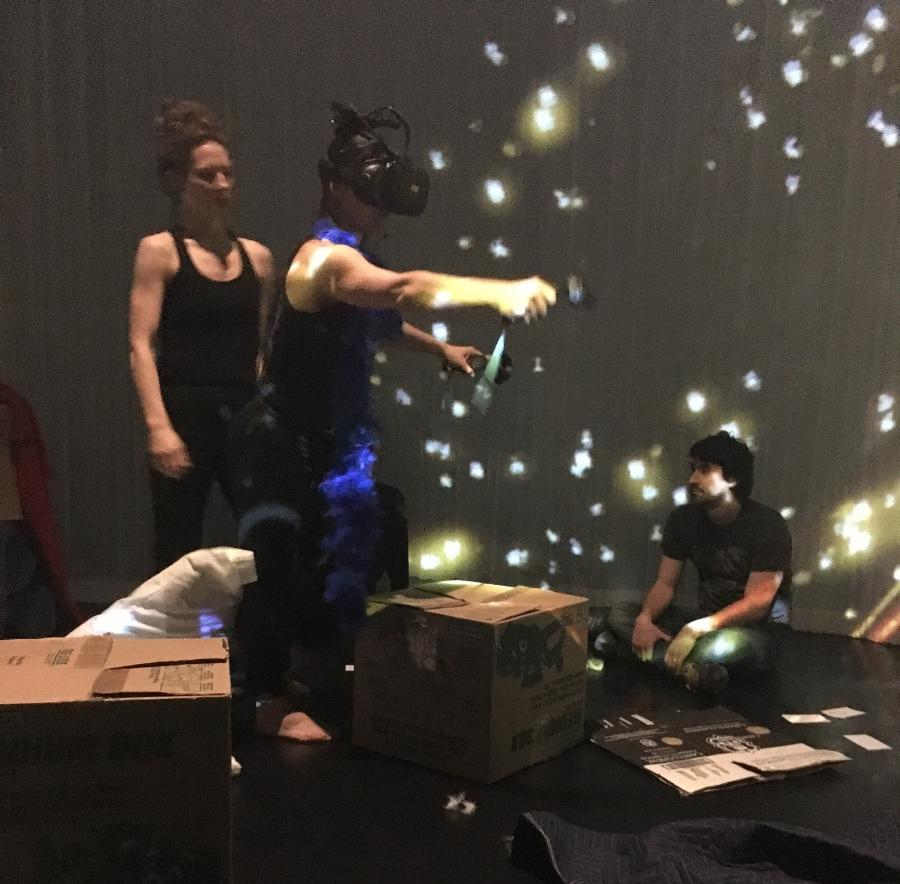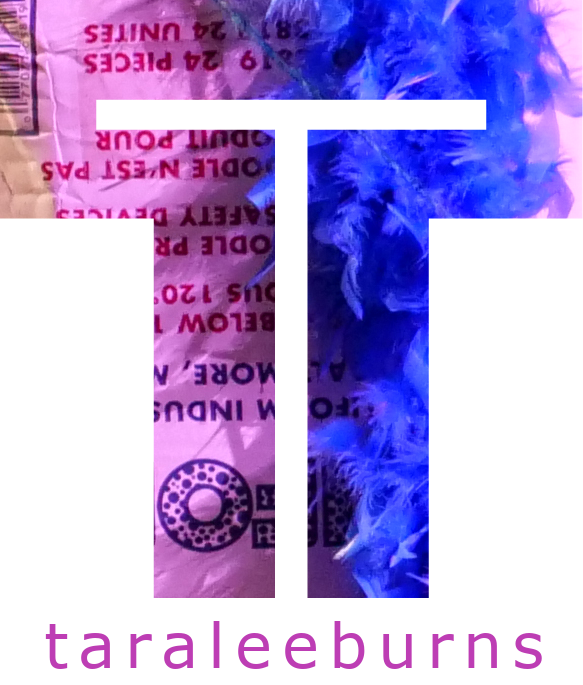
KJ, Tara & Keith
My final “Tilt Brush” iteration this semester was an installation/performance during ACCAD’s open house on April 5th in the Motion Lab. The audience/participants entered a circle of projection screens where cardboard boxes, feather boas, pool noodles, and random small balls littered the space. Tasks were written on cards around the space for the audience to complete such as, “Build a castle.” Two performers were also in the space, one acted as safety and instigator of movement (KJ Dye), while the other (myself) was immersed in VR. As the performance transpired, painted traces of the immersed’s VR experience was projected throughout the space.
I wore the VR headset in the black void of Google’s Tilt Brush and except for running into the occasional cardboard box obstacle or feather boa adornment I was in my own world, a world absent from that of the audience-participants. People came in, sat on blankets or “played” in the space while KJ and I completed our score.
The technology stopped working at the beginning. A tower had been created out of cardboard boxes and was possibly obstructing the view of one of the cameras making it difficult for us to complete part of the score that began on the floor. The house I was to build, the tracing of bodies and the reflection of looking at the house from a transported place had to be skipped over. We completed this iteration with the standing portion of the score.

KJ crawling through a box and Tara wearing a boa. Keith is a spectator.
Documentation was also on the fritz, schedules had been mixed up and although Oded filmed the event, his video was corrupted. Technology often breaks or doesn’t work at moments when I am around. However, even though it didn’t work perfectly, I’m not sure it mattered. From my perspective, my world was cutting out, but from everyone else’s perspective (from what I have gathered so far from people’s explanations of what happened) they didn’t notice. It was swirling, surrounding colors in a space where the audience became performers. They watched me navigate blindly through a messy environment with KJ keeping me safe and directing my movement in alternate routes.
There was a push and pull to KJ and my relationship. Do I allow her to draw for me or do I draw residually? When she stops me, do I let her? Ideas of permission and control came up for me, perhaps, in part, because I wasn’t able to see her. One of the most unexpected things was that I have no memory of what the audience was doing while I was in VR. When performing without a VR headset, I could remember who came to see the event and what they did. But here, I only remember the brief time I took the headset off and hugged my babies because it wasn’t working. That moment is particularly magical for me because it is the only moment I knew what the space looked like and when I took my headset off the first thing I saw were my two girls.
Reflecting back to the beginning of this project, I was planning on short iterations of three different projects. The other two fell away as I became enamored with objects in space and the theory of absence/presence introduced in Dr. Nadine George-Graves Performing Bodies. In Leder’s “The Absent Body” the idea of yourself as nullpoint played right into the idea of yourself in VR. Sensation at the forefront, other theorists exploring perception (Merleau-Ponty), subjection, and the “zero point of orientation” (Husserl) informed my interest in these two worlds.
Finally the use of task to empower the participant in a way that the performer is empowered. Through Freire’s ideas of liberation pedagogy and praxis, I found a connection between Freire’s definition of praxis and what is happening in participant environments. Freire’s definition of praxis, “reflection and action upon the world to transform it,” can be applied to these environments. I was transformed. KJ protected me and the audience’s world left traces that were beautiful, creative and a reminder that they were there too, even though I didn’t see them.
Click here or here to view two of 12 traces created during the semester of rehearsals I had inside of Google’s Tilt Brush. During these rehearsals, I was researching how to create an improvisational score that I would paint live. These are traces 11 and 10. (These links are best viewed and interacted with on a touch screen, like your phone or tablet, you can swipe around to see different angles and zoom in and out. They will only work on computers with enough computing power.)
